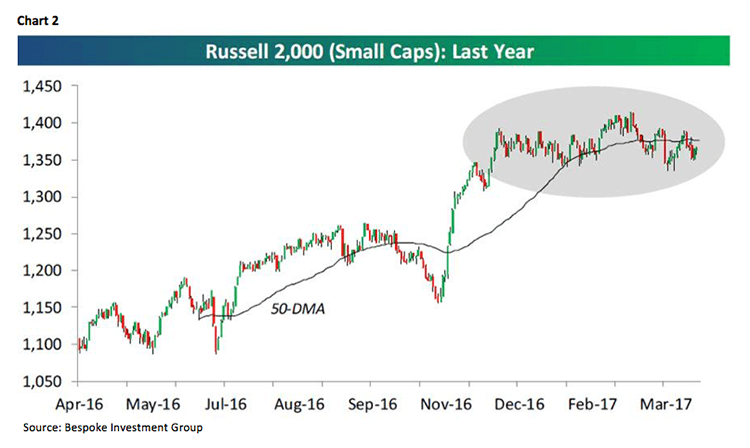by Jeffrey Saut, Chief Investment Strategist, Raymond James
I spoke with uber investor Frederick “Shad” Rowe, captain of Dallas-based Greenbrier Partners, last Thursday. Shad always has great investment insights, and his March letter to investors was no exception. I like Shad’s letter:
Traditionally, there have been two proven, well-worn paths available to investors seeking financial security or riches. The first has been compounding money through the ownership of publicly traded securities. The second has been through being a technology entrepreneur or knowing the right venture capitalists. For most investors the first path was too slow and too unsteady, while the second path produced too little boom and too much bust. Obsessed with its own short-term profitability, Wall Street lost interest in the first path and has been intellectually and financially unequipped to be of any real use with the second path. It was assumed that these two paths were separate and mutually exclusive, making it impossible to travel both paths at the same time. One saw oneself as either a patient investor or as a venture capitalist. I chose the path of patient stock market investing. It was the more conservative approach, but it was the more assured.
Amazingly, however, it would seem as though the two paths have re-converged. The four dominant technology companies we own are Facebook, Apple, Google, and Amazon. These companies, which represent about 45% of our equity at market, have the potential to both compound their earnings predictably and have dramatic step-ups in value – if their venture investments pan out. What is proven and recognized is that these companies have been winners. Everybody gets that. What we believe is proven but not yet recognized is that these companies can be far more than long-term compounders. The companies that we have invested in appear to grow more powerful by the day. They have wonderful business models, massive scale and have (and can attract) the best, most creative people, the best ideas, the best science, the best resources, the most extensive market knowledge, and nearly unlimited venture capital arms funded by their enormous cash flows, so they can buy or build any great technology they want. These companies also have locks on ways of doing things, rather than just locks on individual things, which allows them to evolve.
It has become a winner-take-all world, with only a few winners and many, many losers. Together, FB, AMZN, AAPL and GOOG spent $82 billion on capital expenditures, research and development and acquisitions in 2016. They currently have $289 billion in net cash. This compares to $42 billion raised by 253 venture capital firms in 2016. Further, these companies provide true value to society, sometimes by disrupting the seemingly entrenched monopolies of the past that do things to, rather than for, their customers, and by revolutionizing the ways we do almost everything else, which is really the point. Rather than selling a product or service, what these companies are really selling are new, better and more fun ways of doing things. As we have said before, we want to own the agents of change and avoid the targets of change.
Boy, do I agree with Shad on those points and would note that these companies resemble what Warren Buffett refers to as “companies with an economic moats around them.” According to Investopedia:
The term economic moat, coined and popularized by Warren Buffett, refers to a business' ability to maintain competitive advantages over its competitors in order to protect its long-term profits and market share from competing firms. Remember that a competitive advantage is essentially any factor that allows a company to provide a good or service that is similar to those offered by its competitors and, at the same time, outperform those competitors.
Shad’s investment model is very much reminiscent of this quip from Brown Brothers Harriman: “Our aim is to identify great businesses, buy them [the stock] at a discount and patiently wait for the market to recognize their value. We believe this is the best recipe for consistent long-term investment results. In our book, patience is more than a virtue: it’s a necessity.”
There’s that word “patience” again, and as often opined in these letters, “Patience is the rarest commodity on Wall Street!” So, in mid-February the S&P 500 (SPX/2355.54) was changing hands around 2355 and as of last Friday it closed at 2355.54. Over that timeframe, we have seen mixed economic reports, a Fed rate ratchet, numerous terror tactics, a failed healthcare bill, a stronger and then weaker than estimated employment report, a filibuster, hints that tax reform may take longer than expected, a Tomahawk missile strike on Syria, and the list goes on. Given that skein of events, we find it somewhat bullish that stocks have hung in there. Speaking to last week’s missile strike, it has long been our belief that such events tend to not have any long lasting effect on the various markets, especially if it is a “discrete action” and not the beginning of a broader campaign. Our friends on Capitol Hill suggest that is exactly what last Thursday’s air strike was, a discrete action, which is likely why the market’s response was muted. Still, the SPX was unable to breakout above its downtrend line that has been in effect since the March 1, 2017 high (chart 1). Also worth mentioning is that the SPX once again held above its 50-day moving average (DMA). However, the Russell 2000 (RUT/1364.56) and the D-J Transpiration Average (TRAN/9104.81) have not stayed above their respective 50-DMAs (chart 2 and chart 3). Adding to the mixed signals is the fact that the average stock in the S&P 500 is down 18.4% from its 52-week high. Maybe these conflicting signals will be resolved this week since the stock market’s internal energy has been rebuilt and our models are looking for a “polarity flip.”
Meanwhile, 1Q17 earnings reports are slated to begin this week with expectations for a 9.1% increase in y/y earnings for the S&P 500. If correct, this would further reinforce our belief that the secular bull market has transitioned from interest rate driven to earnings driven.
The call for this week: The SPX has basically been trapped in a trading range between 2335 and 2400 since mid-February of this year as the forces of “light and dark” battle. Meanwhile, as we drill down into the economic numbers, Andrew and I think the economy is just fine. However, last week Jamie Dimon (JP Morgan) and Larry Fink (Blackrock) warned about weakening U.S. economic stats, and on Friday the Atlanta Fed cut its 1Q17 GDP to +0.6% from +1.2%. That comes as 1Q17 earnings are expected to post their strongest gains in years. Indeed, confusing! To reiterate, “Maybe these conflicting signals will be resolved this week since the stock market’s internal energy has been rebuilt and our models are looking for a ‘polarity flip’”. This morning, the preopening futures are again flat as China’s nuclear envoy is in South Korea amid talk of President Trump’s potential action against North Korea. As stated on Friday, “Do not play unless absolutely necessary because the environment is extremely unpredictable.”
Copyright © Raymond James


















